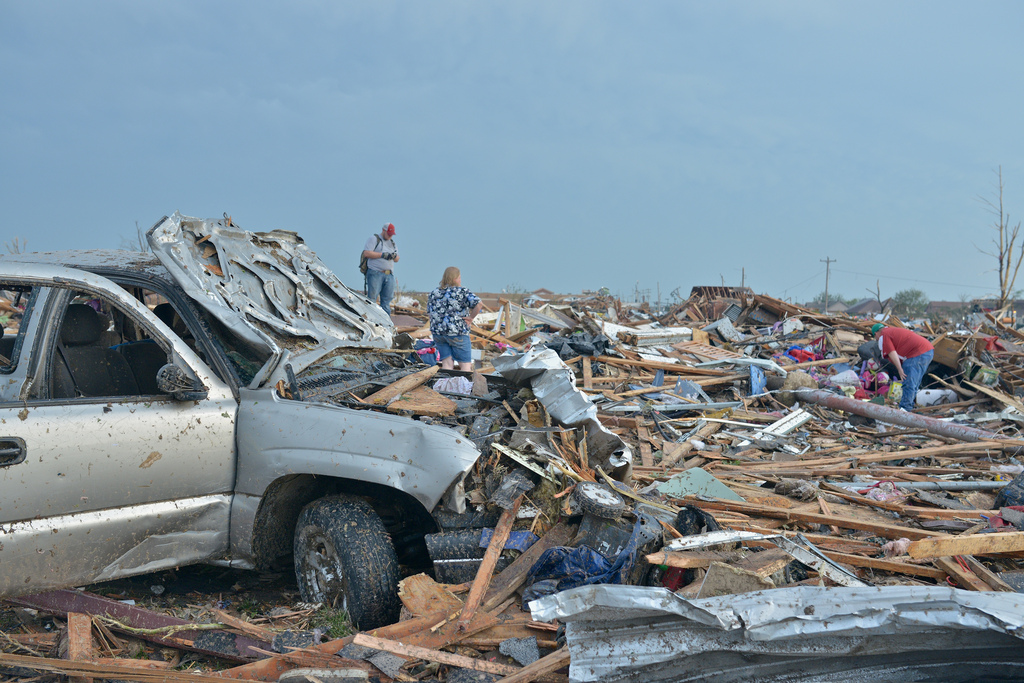
The Surprising Optimism of Tornado Victims (Op-Ed)

Jerry Suls is a social psychologist at the National Cancer Institute at the National Institutes of Health (NIH). Previously, he was a psychology professor at the University of Iowa. He contributed this article to LiveScience's Expert Voices: Op-Ed & Insights.
The people who survived the recent tornado disaster in Oklahoma are in our thoughts, and demand our care and assistance. As a social psychologist, whatever I can offer to help make the situation better for the victims and observers is dwarfed by the sheer magnitude of the tragedy: 24 dead and an entire community leveled by an uncaring and arbitrary menace.
Nonetheless, as William James maintained in the early days of psychology, the goals of that science are to document and improve the human condition. Quite often, problems close to home occupy the social psychologist's attention.
I personally know a little something about the tornado situation in Moore, Okla., as my community was struck by a tornado that roared through downtown Iowa City, Iowa, in April 2006. Unlike Moore, the town of 65,000 suffered no deaths, but the twister resulted in numerous injuries, destruction of residences and businesses totaling millions of dollars, and the relocation of many of its residents. One of my best friends' homes was almost completely destroyed; she escaped physically unharmed. The fact that I had dinner there only an evening before, and was helping to clear debris a day later, only re-emphasized the force of nature and the fragility of life. [Image Gallery: Moore, Okla., Tornado Damage - May 20, 2013]
Although I am not an ambulance chaser, I realized within days that the tornado had created an opportunity to learn from and potentially help victims of weather disasters. Prior to the tornado, my colleagues and I had been studying how people evaluate their risk of experiencing various negative events, such as physical illnesses and traffic accidents. We were following up on previous studies documenting that people tend to believe they are less vulnerable to negative events than their peers are. This phenomenon is considered a bias because everyone cannot be less vulnerable than average. Typically, the bias is referred to as "unrealistic optimism" or the "illusion of nonvulnerability." Our research was trying to determine what motivated the optimism — the need to maintain self-esteem or cognitive factors, or some combination.
Independent of the foundations of unrealistic optimism, there is limited understanding about how the bias unfolds in individuals soon after a negative event actually has occurred. That is, do people remain optimistic about the future if a tornado has recently ripped through their community?
As reported in a recent study published in Personality and Social Psychology Bulletin, my colleagues and I found that yes, people do remain optimistic following a tornado. Over the course of a year, we surveyed three different populations affected by the April 2006 F2 tornado in Iowa: college students, local residents contacted through random-digit dialing and residents in neighborhoods affected by the tornado.
Sign up for the Live Science daily newsletter now
Get the world’s most fascinating discoveries delivered straight to your inbox.
The predominant pattern for the populations in the year following the tornado was that people felt they were less likely than their peers to be injured by a future tornado. For the first six months, people who lived in neighborhoods that had been directly affected by the storm (e.g., damaged windows, roofs, other structures, automobiles) actually were more optimistic than people living in neighborhoods that had no visible damage from the storm. We speculated that for a while, they felt "lightning wouldn't strike twice in the same place." A year later, their optimism was comparable to that of the people in the undamaged neighborhoods.
One other finding was noteworthy: When people were asked what their "objective estimate" of risk was — that is, the statistical likelihood of tornadoes — they tended to give more pessimistic numbers than those generated by storm-weather experts. The surveyed participants believed they had approximately a 1-in-10 chance of injury from future tornadoes — an overestimate of the scientifically calculated risk of less than 1 in 100. [5 Tornado Safety Myths Debunked]
So what does this all mean, especially for the victims of the recent Midwest storms? We found that even the proximity of a significant weather disaster seems to do little to shake optimism. Although that optimism may be good for morale, it could undermine emergency-preparedness efforts. As affected towns rebuild, they need both hope and a realistic expectation of future disaster risk to decide how best to prepare for future events — whether that includes building more storm shelters or changing evacuation procedures.
With the apparent recent increase in weather disasters in recent years, we need to continue studying this issue — in particular, whether these disasters are having a cumulative effect on people's optimism and feelings of vulnerability. Over the last week alone, 91 tornadoes have torn through the Midwest.
We are still unsure about the reasons for the relative optimism. Maybe it is because of the "lightning doesn't strike twice" belief, or maybe people are just elated that they "dodged a bullet." We also cannot rule out the idea that living for a long period amid the rubble (rebuilding can take years) could increase victims' defensiveness and, perhaps, denial.
Unfortunately, in Moore's case, lightning did strike twice. If we are to help prevent future tragedies of this kind, we need to better understand and respond to the perceptions and behaviors of the people impacted most by severe weather.
The views expressed are those of the author and do not necessarily reflect the views of the publisher. This article was originally published on LiveScience.com.









